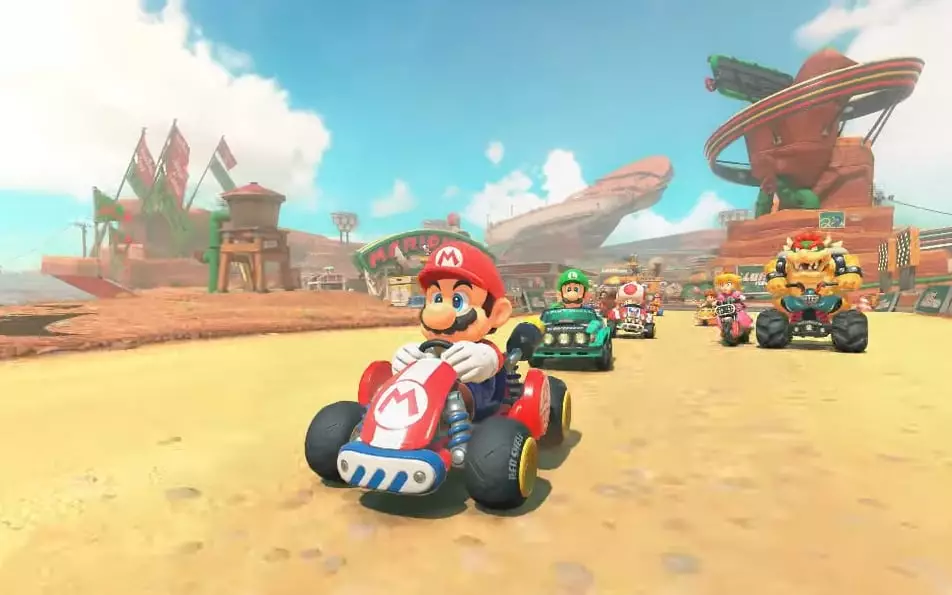As Nintendo fans eagerly await the unveiling of the next-generation console, the prospect of Mario Kart 9 as the flagship launch title for the Switch 2 ignites both excitement and skepticism. This highly anticipated game is expected to showcase polished graphics, innovative gameplay mechanics, and a broader range of characters and tracks. Historically, the Mario Kart franchise has captivated audiences worldwide, leading to remarkable sales figures. However, the shadow of Mario Kart 8 Deluxe looms large, raising critical questions about whether Mario Kart 9 can effectively galvanize consumers and elevate the Switch 2 to iconic status.
The overwhelming success of Mario Kart 8 Deluxe, which has amassed upwards of 67 million units sold, sets a formidable benchmark for its successor. This figure takes on even greater significance when you consider that it incorporates sales from the previous platform—Wii U—where the original Mario Kart 8 experienced lackluster performance. Astoundingly, what was initially perceived as an “afterthought” for the Switch has morphed into a cornerstone of the console’s identity. The challenge Mario Kart 9 faces is not merely to replicate this success, but to surpass it significantly.
Consumer Reluctance and Market Dynamics
Former Nintendo employees Kit and Krysta, who now operate a YouTube channel and analyze the gaming landscape, express caution regarding the prospect of Mario Kart 9 serving as a compelling factor for Switch owners to upgrade. Their recent discussions underline a crucial dilemma: is the allure of a new game substantial enough to entice franchise fans to invest in a new console, especially when they already enjoy a beloved title? The financial ramifications for everyday consumers cannot be overlooked.
Krysta’s comments encapsulate a prevailing sentiment where even enthusiastic fans may hesitate to persuade their parents or guardians to shell out $400 on a new console solely for a sequel. When products must compete against existing success and emotional nostalgia, immediate purchase motivations can become clouded. Simply put, for many casual users, Mario Kart 8 Deluxe remains a potent experience that offers continuous enjoyment through its ongoing content updates. The install base of the current Nintendo Switch is also a crucial factor—there may be more than 100 million of these devices in homes globally. This highlights a certain inertia; why expend the resources on another console when the existing one already provides access to a robust library of games?
Comparisons to Iconic Previous Launch Titles
Looking back at iconic launch titles, we see how certain games, like The Legend of Zelda: Breath of the Wild, delivered essential experiences that were inextricably tied to the console’s identity. Many gamers deemed it a “must-have,” and its striking graphics and engaging narratives seamlessly ushered many to upgrade from the Wii U to Switch. By contrast, Mario Kart 9’s challenge lies in distinguishing itself not just as another enjoyable racing title, but as an essential experience that justifies the Switch 2’s existence.
Nintendo’s self-aware approach indicates that the company understands it must not only design a game that fans adore but also ensure that it carries a hefty weight as a system seller. Kit’s perspective further emphasizes this point, remarking that the brand aspirations rest upon creating a product that surpasses its predecessor’s extraordinary sales figures. This brings attention not only to gameplay innovation but also to marketing strategies and how the game is positioned in a saturated gaming landscape.
The Future of Mario Kart and Nintendo’s Challenges
The realities of this saturated market and the long acceptance of Mario Kart 8 Deluxe necessitate that Nintendo approaches the next installment with creativity. Offering fresh experiences, varied gameplay modes, and increased engagement opportunities could entice players back into the fold. Fan expectations will be a double-edged sword; while they may elevate excitement, they can set the stage for disappointment if the product does not meet or exceed lofty standards.
Ultimately, Mario Kart 9 could potentially usher the Switch 2 into a new era, but not without adequately addressing the existing community’s attachment to its predecessor. Strategic positioning and a robust marketing campaign are imperative to navigate this intricate landscape. For many fans, the allure of Mario Kart 9 must translate into a definitive showcase of innovation to become the irreplaceable launch title that convinces gamers to jump aboard the Switch 2 bandwagon. Will this thrilling new entry indeed spark enough enthusiasm to make day-one purchases a reality, or will Nintendo’s renowned creativity struggle to break through consumer hesitance?

